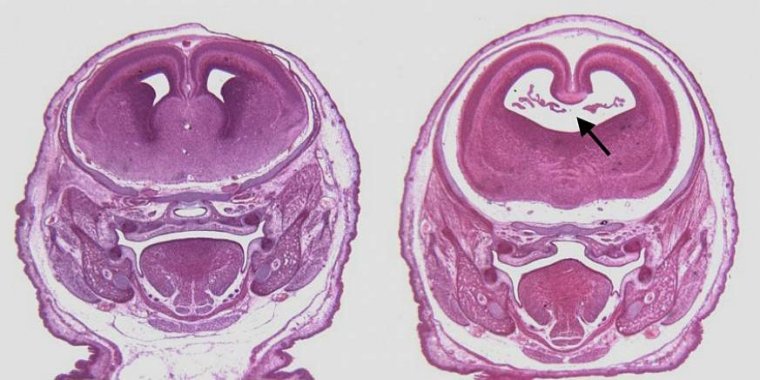| Health / Health News |
Using both marijuana and alcohol during early pregnancy may increase the likelihood of disrupting fetal development
New preclinical research reported in animal models shows that exposure to compounds found in marijuana called cannabinoids (CBs), which includes cannabidiol (CBD) and tetrahydrocannabinol (THC), during early pregnancy can cause malformations in the developing embryo. The research also demonstrated that co-exposure to CBs and alcohol increased the likelihood of birth defects involving the face and brain.

Stained sections of fetal mouse brains. (Left) Control. (Right) Mouse exposed to alcohol and a cannabinoid on the 8th day of pregnancy. Black arrow highlights enlarged cerebral ventricle caused by the loss of the midline septal region. Photo: Dr. Scott Parnell/UNC Chapel Hilll
The detrimental effects of prenatal alcohol exposure on human development are well known and include an array of lifelong physical, cognitive, and behavioral problems collectively called fetal alcohol spectrum disorders (FASD).
Alcohol can disrupt fetal development at any stage during pregnancy, even the earliest stages before a woman knows she is pregnant. The effects of marijuana exposure during pregnancy and the combined effect of alcohol and marijuana are less known.
In the study, scientists led by Scott Parnell, Ph.D., at the Bowles Center for Alcohol Studies at the University of North Carolina in Chapel Hill, administered a variety of CBs alone and in combination with alcohol in varying amounts to mice on day eight of pregnancy, which is similar to the third and fourth weeks of pregnancy in humans.
The CBD amounts administered were within what is considered a therapeutic range for several medical conditions in humans. The THC concentration administered was similar to levels reached by a person smoking marijuana.
The researchers found that one-time exposure to CBD and THC caused eye, brain, and facial malformations similar to those caused by prenatal alcohol exposure alone.
The researchers also found that when mice were given both CBs and alcohol, the likelihood of these birth defects more than doubled. They confirmed this finding in a zebrafish model.
Further investigation by Parnell’s team revealed clues about the mechanisms by which alcohol and CBs interact at the cellular level. They found that alcohol and CBs converge on the Sonic Hedgehog pathway to inhibit signaling between molecules in cells that control growth and development in the embryo.
The Sonic Hedgehog pathway plays a key role in the development of animals and humans. (National Institutes of Health)
YOU MAY ALSO LIKE





